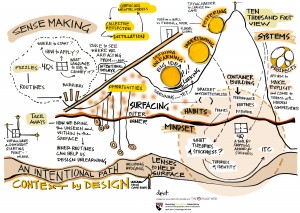Unlearning to Learn: A 10,000 Foot View
David Perkins offered his third installment of a “10,000 ft.” view synthesizing where we are in our story about Unlearning for the year. He began by reminding us that our three “quests” have been to define, understand and foster Unlearning, and that today’s synthesis would focus on our progress in these quests through the systems lens.
Defining Unlearning
Perkins situated his synthesis by noting that from the start of the year we’ve held a big idea: unlearning is necessary when we face interference from prior learning. We’ve come to see, he says, that Unlearning is not about erasing prior learning, but rather about sidelining it because it tends to “lurk around.” Concerning the systems side of the story, Perkins made reference to our research memo and the ways that scholars see things, pointing out that it is different from mindsets and habits – we can’t just “bracket” those. There are instances though, in the system level, when something can be bracketed and contextualized more narrowly. However, he noted, this work is not easy.
Understanding Unlearning
Perkins continued by framing our quest to understand Unlearning by noting that we held another big idea – that the nature of unlearning was one of overcoming “stuckness.” He reminded us that when we talked about mindsets, we talked about identity “stuckness,” and when we talked about habits, we talked about habit “stuckness.” In particular, we found that habit stuckness occurs when our habits become disassociated from their goals (i.e., stuck in a local perspective, without a longer, global view). He also reminded us that we shouldn’t think of Unlearning as a fundamental roadblock – most of the time, he noted, it is not in our way.
Next Perkins folded in ideas from a systems perspective that add to our understanding of Unlearning. One idea comes from considering Wilbur’s 4 Quadrants, which gives us a way to conduct an organizational analysis of the inner/outer and me/us domains. It is, Perkins says, an invitation to “shop around” for where our “stuckness” might be and can serve as a good tool for discovery. Another idea comes from Feldman’s approach to considering the performative and ostensive sides of organizational routines to identify where difficulties come from. Yet another idea is that routines are more “editable” than habits. Finally, there is the Immunity to Change framework that applies well to organizations because they, like individuals, hold entrenched, hidden commitments that impede their ability to attain the goals they have for themselves. Ultimately, he says, it’s about surfacing tools, lenses, and ways of looking at things to examine what is “underneath.”
Fostering Unlearning
In terms of fostering Unlearning, the big question Perkins posed is: Where can we get some leverage? One big idea, he says, is that we need to shift from trying harder to changing the game. He noted however, that trying harder can work, but when it doesn’t work, the problem is that we usually try harder, again. Therefore, part of our need is to escape from the trying harder track (or the rut we get into when we keep doing it) – we need to “find or build a door” rather than continue to push on the wall.
Before moving the systems level, Perkins reminded us about what we’ve learned about fostering Unlearning from the habits and the mindsets perspectives. For example, he reminded us of Pratt’s findings about conflicts between administrators and doctors – their work was to shift their identity of self and their role. For Becker, there was an emphasis on conversations being about coming to understand other’s POV, not change their mind. Wood shared ideas about the “power of disruption” as a way to “change the game” (i.e., eat popcorn with non-dominant hand). Heyman’s research on addiction intimated how shifting from a local to a global perspective can do so.
To get underneath how this can play out at the systems level in practice, Perkins synthesized a number of ways we can support changing the game. One is that because the ostensive side of routines are “unwritten” or “tacit” we need to make the ostensive explicit. Another comes from the Immunity to Change model, which allows us to make our practice explicit by identifying a hidden commitment and the assumption that lies behind it in order to develop a hypothesis to explore. Through the 4 Quadrants lens we can identify the “sector” where a problem is and then use a “nudge” to change the game board. Finally, we learned about the DDO as a “container” for all of this, but, he reminded us, there is a catch: we have to build the container.
In closing, Perkins suggested that what we get from these frameworks are prospects, not recipes, for solving our problems and lenses through which to see our gridlock…and “that’s the best we can do – have good things to try out.”

